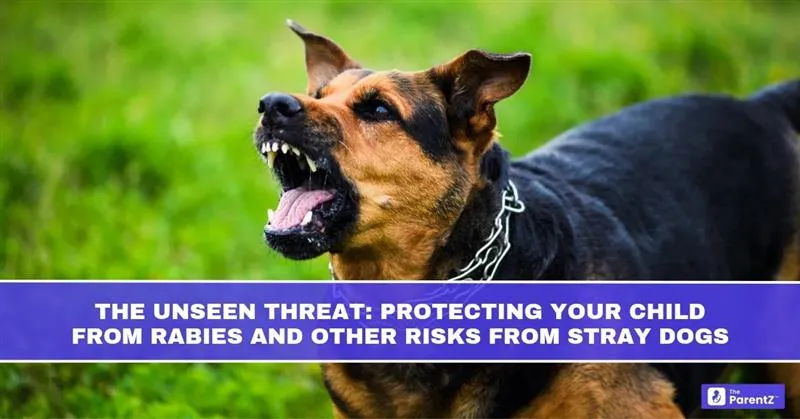Stray Dogs in India: A Familiar Yet Overlooked Risk
Children playing cricket in the lane, families visiting markets, or evening walks in the park—these everyday moments often include the sight of stray dogs nearby. For many children, curiosity takes over: some may try to pet them, others run away in fear. While not every stray dog is dangerous, the risks they carry are far greater than most parents realise. Beyond bites and scratches, the hidden threat is rabies, a disease that is almost always fatal if untreated, yet completely preventable.
Rabies: A Silent but Deadly Danger
Rabies remains one of the most feared infections worldwide. India, unfortunately, bears the highest burden, contributing to nearly one-third of global rabies deaths according to the World Health Organization. The tragedy is that most victims are children under 15.
Why is rabies such a concern?
- The virus spreads through saliva during a dog bite or even a lick on broken skin.
- Symptoms of fever, tingling at the bite site, confusion, or hydrophobia develop only when it’s too late for treatment.
- Once clinical symptoms begin, survival is nearly impossible.
This is why prevention is everything. Any bite, even a “small nip,” must be taken seriously.
Why Children Are at Higher Risk
Children are naturally curious and less aware of danger signals. Unlike adults, they may not notice the warning signs of an irritated dog, such as growling, stiff posture, or tail held rigidly. Their playful behaviour, like running, shouting, or reaching out to touch, can trigger defensive attacks.
Physically, their smaller height places their face, neck, and arms directly in a dog’s striking range. These areas, when bitten, carry the highest risk for rabies transmission because the virus travels quickly to the brain.
More Than Rabies: Other Health Concerns
Rabies isn’t the only concern linked to stray dog bites or exposure. Children may also face:
- Severe wound infections: Dog mouths contain bacteria such as Pasteurella and Capnocytophaga that can cause cellulitis, abscesses, or sepsis.
- Tetanus risk: A neglected bite can serve as an entry point for Clostridium tetani.
- Parasitic infections: Stray dogs may harbour intestinal worms or skin parasites that indirectly affect children who play in contaminated soil.
- Psychological trauma: Beyond the physical wound, being chased or bitten can lead to anxiety, sleep disturbances, and a lasting fear of animals.
Why the Stray Dog Population Keeps Rising
Understanding the root cause is important. India has an estimated 15–20 million stray dogs. Urbanisation, open garbage dumps, and irregular sterilisation programs all contribute to this growing population. Feeding practices without vaccination or sterilisation further worsen the issue, as dogs gather in groups and become territorial.
For children, this means more frequent encounters and therefore more risk.
Recognising Dangerous Situations
Parents must teach children to read and respond safely to situations with stray dogs. A few key scenarios to watch out for:
- Dog packs near garbage sites: Hunger and group behavior make them unpredictable.
- Dogs with new puppies: Protective mothers may attack if a child comes too close.
- Night-time encounters: Dogs are more alert and territorial after dark.
- Chasing games: Running children may unintentionally trigger a dog’s instinct to chase.
What To Do If a Child is Bitten or Scratched
Immediate action can save lives. Parents should follow the “golden hour” principle: act quickly and decisively.
- Wash the wound thoroughly under running water with soap for at least 15 minutes.
- Apply antiseptic such as povidone iodine.
- Do not cover tightly, leave the wound open to reduce infection risk.
- Seek medical care immediately, a doctor will decide on rabies vaccination and immunoglobulin, depending on the type of bite.
- Check tetanus vaccination status, a booster may be required.
Delaying care, even by a day, can mean the difference between life and death.
Preventive Strategies for Parents
The goal isn’t to create fear, but to equip families with practical tools:
- Teach children not to approach or feed stray dogs.
- Encourage calm behavior: no screaming, chasing, or teasing.
- If a dog comes close, children should stand still, avoid eye contact, and slowly back away.
- Always supervise toddlers in open spaces.
- Ensure your child’s vaccination schedule is updated, especially tetanus.
- If your family lives in a high-risk area, ask your doctor about pre-exposure rabies vaccination for children.
The Role of Communities and Policy
Protecting children is not only an individual responsibility but also a community one. Municipal authorities need stronger sterilisation and vaccination drives, better waste management to reduce food sources, and accessible anti-rabies treatment centres.
Schools can also play a part by teaching children safe behaviour around animals as part of health education. Compassion toward stray dogs must coexist with strict public health measures because neglecting either leads to greater harm.
Supporting a Balanced Perspective
It’s important to remember that most stray dogs are not naturally aggressive. They are products of hunger, fear, and survival in a challenging environment. Teaching children kindness, paired with caution, prevents unnecessary cruelty while still prioritising safety. Parents can model this balance by avoiding reckless feeding practices but supporting organised animal welfare programs that focus on sterilisation and vaccination.
Conclusion
Stray dogs are an undeniable part of India’s streets, but their presence must not put children at risk. Rabies remains one of the most preventable tragedies in modern medicine, and yet it continues to claim thousands of young lives each year. By staying alert, responding quickly to bites, and teaching children safe behaviour, parents can shield their children from both the physical and emotional scars of dog encounters.








Be the first one to comment on this story.